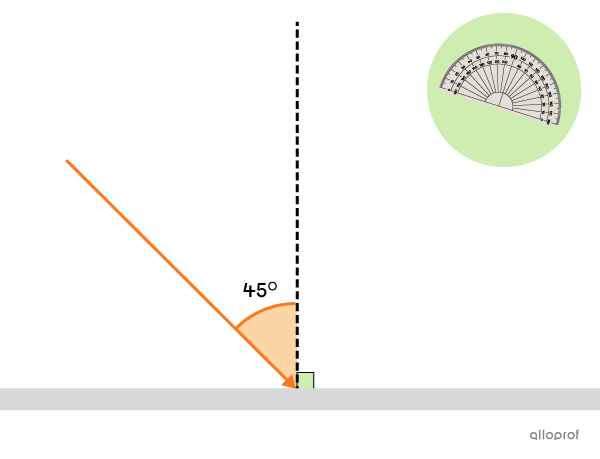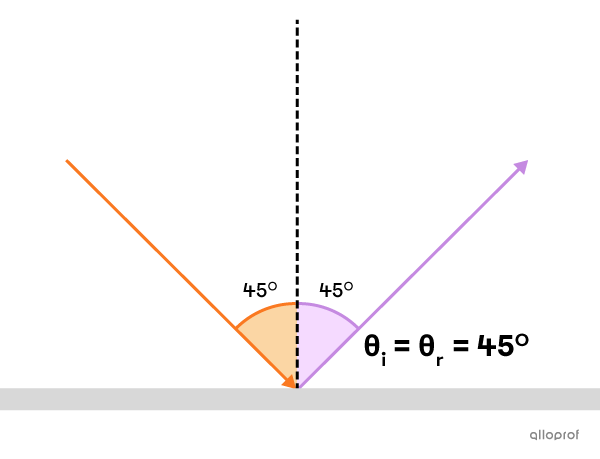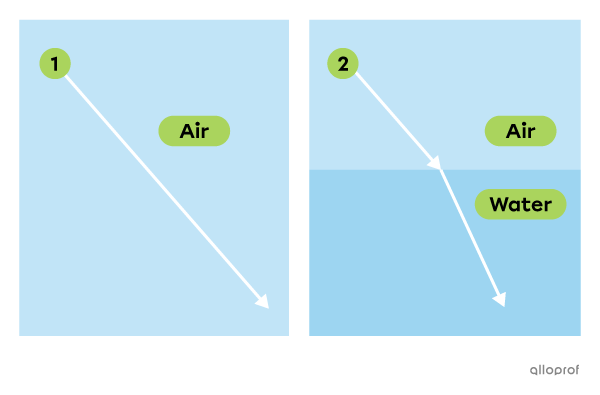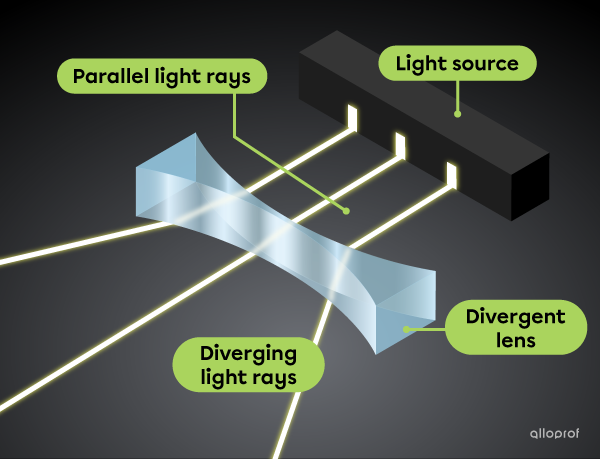-
A wave is a disturbance that travels in matter or in a vacuum.
-
A light wave, also called light, is an electromagnetic wave with a wavelength that is within the spectrum of visible light.
To visualize the propagation of light, the light rays are represented by straight and thin arrows. The arrows are oriented so their starting point is the light source and the arrow indicates the direction the light is travelling in.
The arrows indicate the direction of the light rays emitted by the projector bulb (light source).

Light reflection is the phenomenon where light rays bounce off a surface.
There are two types of light reflection depending on the direction of the reflected rays: specular reflection and diffuse reflection.
When light rays encounter a perfectly flat or polished surface, they are reflected in a parallel manner. It is called a specular reflection.

When light rays encounter an uneven or rough surface, they are reflected in all directions. It is called diffuse reflection.

When light strikes a perfectly smooth surface, all light rays are reflected symmetrically. Therefore, all the reflected rays are parallel to each other and the image formed is identical to the object.
Both situations illustrate specular reflection. We observe the formation of two identical images of a dog. One of the images is formed in a puddle and the other is formed in the side mirror of a car.

Bachkova Natalia, Shutterstock.com

Photo TrippingAmerica, Shutterstock.com
An observer can see the cat's reflection on the surface of the mirror, because the light rays are reflected parallel to and towards the observer’s eye.

Adapté de anmbph, Shutterstock.com
Determine the Angle of Reflection on a Plane Mirror
-
The incident ray is the one directed towards the reflective surface (mirror).
-
The point of incidence is where the incident ray hits the mirror.
-
The normal is a line perpendicular to the mirror drawn at the point of incidence of the light ray.
-
The reflected ray is the ray leaving the reflective surface.
-
The angle of incidence |(\theta_\text{i})| is the measure of the angle between the incident ray and the normal.
-
The angle of reflection |(\theta_\text{r})| is the measure of the angle between the reflected ray and the normal.

During reflection, the light ray is reflected at the same angle as the incident ray relative to the normal.

|\theta_{i}=\theta_{r}|
where
|\theta_{i}| is the measure of the angle of incidence in degrees |(^{\circ})|
|\theta_{r}| is the measure of the angle of reflection in degrees |(^{\circ})|
Determine the angle of reflection when an incident ray hits a mirror at an angle of |67^{\circ}| relative to the mirror.

Here, the angle between the incident ray and the mirror is given. Use the value to determine |\theta_{i},| the measure of the angle between the normal and the incident ray.
|\theta_{r}=?|
The normal forms an angle of |90^{\circ}| with the mirror.
|\begin{align}\theta_{i}&=90^{\circ}-67^{\circ}=23^{\circ}\\ \theta_{i}&=\theta_{r}\\ \theta_{r}&=23^{\circ}\end{align}|
So, the measure of the angle of reflection is |23^{\circ}.|

Determine the angle of reflection in the graph shown on the right.

|\theta_{r}=?|
To determine the angle of reflection graphically, use a protractor and a square.
Using the square, draw the normal perpendicular to the mirror at the point of incidence.
The normal must form an angle of |90^{\circ}| with the mirror.

Using the protractor, measure |\theta_{i}| (the angle between the normal and the incident ray).
It comes to |45^{\circ}.|
Therefore, |\theta_{i}=45^{\circ}.|

Because |\theta_\text{i}=\theta_{r},|
|\theta_{r}=45^{\circ}|
The measure of the angle of reflection is |45^{\circ}.|

The following concepts are covered in Secondary 5 physics.
Diffuse reflection occurs on uneven surfaces.
Fabrics, grass, and an orange peel are examples of uneven surfaces on which light is diffusely reflected.

Riderfoot, Shutterstock.com

Jon Rehg, Shutterstock.com

domnitsky, Shutterstock.com
A cat's fur is an uneven surface. Light rays that hit the fur parallel to each other are reflected in all directions. This phenomenon is represented by the white and orange arrows.

Adapté de andia, Shutterstock.com
Diffuse reflection does not produce a reflection like in a mirror, but it allows us to observe the world around us. Visible light is actually reflected on objects, and then in all directions including our eyes, the organs of sight.
The way light is reflected by objects tells us about their colour, shape, etc. Without the reflection of light, humans would live in complete darkness.
When the orange light is reflected and the other colours are absorbed, the eye perceives the orange colour only.


Adapté de Chendongshan, Shutterstock.com
Refraction is the deflection (bending) of a light ray as it passes from one transparent medium to another.
Media with the ability to deflect light rays are called refractive.
When light travels through a transparent medium (e.g., air), its speed is constant. However, if it passes through another transparent medium (for example, water), its speed of propagation changes. The change in speed causes the ray to deviate from its original path.
-
A light ray travels through the air at a constant speed. The light ray is not deflected.
-
A light ray travels through the air and then through the water. As it enters water, the speed of light changes. The light ray is deflected, and continues to travel.

Refraction changes our perception of objects when viewed through a transparent medium.
When we dip a pencil in a glass of water, a distorted and shifted image of the pencil can be observed.

Kuki Ladron Guevara, Shutterstock.com
By using a curved transparent medium such as a lens, light can be deflected.
In the lab, a light source emits three parallel light rays towards a converging lens. The following facts can be observed:
-
Light rays pass through the converging lens.
-
As they exit the lens, the light rays are deflected and come closer together.

In the lab, a light source emits three parallel light rays towards a diverging lens. The following facts can be observed:
-
The light rays pass through the diverging lens.
-
As they exit the lens, the light rays are deflected and move away from each other.

Light dispersion is the optical phenomenon that explains why white light is separated into its constituent colours when passing through a transparent medium.
In a rainbow, the water droplets suspended in the air act like prisms, separating the colours.
During dispersion, the light is separated into seven monochromatic rays (formed by a single ray), namely red, orange, yellow, green, blue, indigo, and violet.

S.Borisov, Shutterstock.com
The following concepts are covered in Secondary 5 physics.